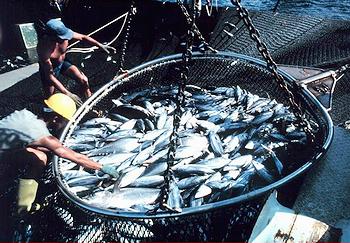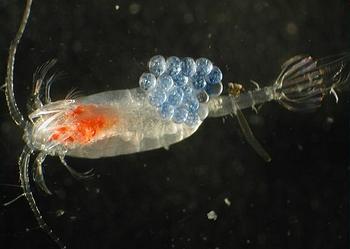
SANTA BARBARA, California, August 5, 2013 (ENS) – Warming oceans are causing marine species to change their breeding times and shift their habitats toward the poles much faster than land-based species, finds new research by scientists at 17 institutions across the world.
The researchers warn that these big shifts in the timing of major events could produce disruption to ocean food webs, affecting all sea life, as well as humans who depend on the sea for food.

Findings of the three-year research project, conducted by a working group of University of California, Santa Barbara’s National Center for Ecological Analysis and Synthesis, NCEAS, and funded by the U.S. National Science Foundation, are published in the current issue of the journal “Nature Climate Change.”
The report, “Global imprint of climate change on marine life,” will form part of the Intergovernmental Panel for Climate Change, IPCC, Assessment Report due for publication in 2014. Based in Geneva, the UN-backed IPCC assesses scientific, technical, and socioeconomic information concerning climate change, its effects, and options for adaptation and mitigation.
“The effects of climate change on marine species have not been a major focus of past IPCC reports because no one had done the work to pull together all the disparate observations from around the world,” said NCEAS associate Carrie Kappel. “This study provides a solid basis for including marine impacts in the latest global accounting of how climate change is affecting our world.”
Unlike previous studies that relied on terrestrial data to estimate the impacts of climate change on oceans, this research team assembled a marine-only database of 1,735 changes in marine life from the global peer-reviewed literature. The studies have an average length of 40 years of observation.
The team found that 81 percent of changes across different populations and ocean basins were consistent with the expected impacts of climate change.
The study took in research from all the world’s oceans, with particular focus on the east and south coasts of Australia, both U.S. coastlines, the European Atlantic Ocean and the Mediterranean Sea.

(Photo by Andrew David, NOAA/NMFS/SEFSC)
It included marine mammals, fish, seabirds, turtles, squid, plankton, molluscs, deep sea invertebrates and crustaceans, mangroves, seagrasses and deepwater algae and covered the polar, temperate, subtropical and tropical oceans.
The study offers a “very simple, but important message” says one of the lead authors, Professor Camille Parmesan, National Marine Aquarium Chair in Public Understanding of Oceans and Human Health at Plymouth University’s Marine Institute in the UK.
“This is the first comprehensive documentation of what is happening in our marine systems in relation to climate change,” said Parmesan. “What it reveals is that the changes that are occurring on land are being matched by the oceans. And far from being a buffer and displaying more minor changes, what we’re seeing is a far stronger response from the oceans.”
Parmesan has been active in IPCC since 1997, and in her capacity as a lead author, she shared in the award of the 2007 Nobel Peace Prize to IPCC. In addition to her work at Plymouth, she serves as a professor in the Department of Integrative Biology at University of Texas at Austin.
“Here’s a totally different system with its own unique set of complexities and subtleties,” said Parmesan. “Yet the overall impacts of recent climate change remain the same: an overwhelming response of species shifting where and when they live in an attempt to track a shifting climate.”

Phytoplankton, zooplankton, and bony fish showed the largest shifts. The “front line” of some of these marine species is moving towards the poles at the average rate of 72 kilometers (45 miles) per decade, which is faster than the terrestrial average of six km (four miles) per decade, even though sea surface temperatures are warming three times slower than land temperatures.
The timing of nature’s springtime calendar in the oceans has advanced by more than four days, nearly twice the figure for its advancement on land, the research team learned.
The study found phytoplankton – which provide the basic food for all life in the seas – are now blooming an average of six days earlier in the season, compared with land plants. Baby fish appear to be hatching around 11 days earlier in the season.
“The results were quite a shock,” says co-author Professor John Pandolfi of the ARC Centre of Excellence for Coral Reef Studies and University of Queensland. “We found that changes in sea life attributable to a one degree increase in the Earth’s overall temperature appear much greater than those seen in life on land so far.”
The oceans are estimated to have absorbed 80 percent of the extra heat put into the Earth system by human use of fossil fuels, but have nevertheless warmed more slowly than the land owing to their huge mass, said Pandolfi. “This makes the very large changes in the behavior of sea life all the more surprising.”
“When you see changes as large as these, life generally has three options – migration, adaptation or extinction. In the case of migration and extinction, these can directly affect industries like fishing and tourism which depend on local sea life,” he said.
“On the other hand, as sea life moves around the planet and adapts to the changes, new opportunities may also open up – so it isn’t all bad news,” Pandolfi said.
“The study tells us that the situation with life in the oceans is now very dynamic and fast-changing, and marine managers, fishers and others who depend on the seas for a living need to take account of that,” he said. “For example, we need to minimize the sorts of stresses we put on sea life to give it the best chance of re-establishing in new places and environments.”
Co-author Pippa Moore, lecturer in aquatic biology at Aberystwyth University in Wales, agrees, saying, “These results highlight the urgent need for governments around the globe to develop adaptive management plans to ensure the continued sustainability of the world’s oceans and the goods and services they provide to human society.”
Copyright Environment News Service (ENS) 2013. All rights reserved.
© 2013, Environment News Service. All rights reserved. Content may be quoted only with proper attribution and a direct link to the original article. Full reproduction is prohibited.
